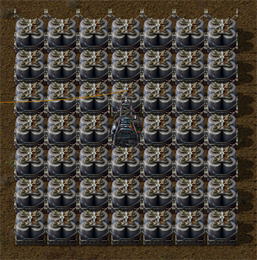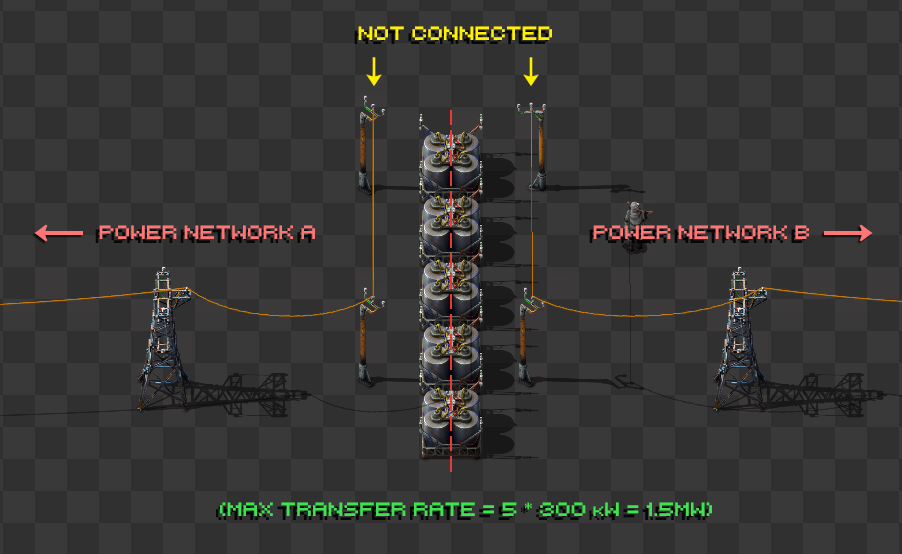Accumulator: Difference between revisions
m (Add MJ for making it through the night) |
LowBattery (talk | contribs) No edit summary |
||
| Line 2: | Line 2: | ||
{{:Accumulator/infobox}} | {{:Accumulator/infobox}} | ||
The | The accumulator stores a limited amount of energy when available production exceeds demand, and releases it in the opposite case. The accumulator can store up to 5 MJ of energy. Its charge/discharge rate is 300 kW maximum. | ||
== Notes == | == Notes == | ||
* 5MJ of stored energy | * 5MJ of stored energy takes approximately 17s to fully charge/discharge at the maximum rate of 300kW. Read [[Game-second]] for further time related calculations. | ||
* It takes 25 accumulators (125MJ) to maintain 1MW through the night | * It takes 25 accumulators (125MJ) to maintain 1MW through the night. | ||
* When discharged above maximum speed by multiple unconnected poles, will | * When discharged above maximum speed by multiple unconnected poles, energy will not be distributed equally (some loads may get 100% demand, others 0%) | ||
* May be used to provide limited amount of power (multiples of maximum charge rate) to a section of the grid | * May be used to provide a limited amount of power (multiples of maximum charge rate) to a section of the grid. | ||
* Produces light when charging and discharging | * Produces light when charging and discharging. | ||
* Can act as | * Can act as an emergency backup for your base in case of blackout, until main power supply is restored. | ||
* Can be used to power the base at night if it relies heavily on [[solar panel]]s | * Can be used to power the base at night if it relies heavily on [[solar panel]]s. | ||
* Can act | * Can act to satisfy surging demands of certain loads. If the power usage of one device exceeds production for a few seconds or so, the accumulator can provide power to the grid until said device shuts down or requires a lesser power requirement. | ||
== Circuit Network == | == Circuit Network == | ||
| Line 37: | Line 37: | ||
This technique can be used whenever this type of isolation is desired. | This technique can be used whenever this type of isolation is desired. | ||
==== | ==== Reduction of Energy Consumption in Critical Situations ==== | ||
In particular, one good use for the above technique is to limit electricity consumption in low power situations by isolating non-critical parts of your factory (such as [[Radar]], [[Lab]]s, [[Electric furnace]]s, [[Electric mining drill|electric miner]]s, [[Beacon]]s, etc.) from critical parts (such as lasers, ammo production, or whatever your priorities are). | In particular, one good use for the above technique is to limit electricity consumption in low power situations by isolating non-critical parts of your factory (such as [[Radar]], [[Lab]]s, [[Electric furnace]]s, [[Electric mining drill|electric miner]]s, [[Beacon]]s, etc.) from critical parts (such as lasers, ammo production, or whatever your priorities are). | ||
| Line 46: | Line 46: | ||
* The rate will always be limited to 300 kW per accumulator. | * The rate will always be limited to 300 kW per accumulator. | ||
Because the accumulators will only receive power if you have a surplus on the main network, this will in effect deactivate the low-priority network when electricity is in short supply. This will also limit power consumption | Because the accumulators will only receive power if you have a surplus on the main network, this will in effect deactivate the low-priority network when electricity is in short supply. This will also limit power consumption of the low priority network if its usage becomes high, for example if you have two factories on a low priority network and usually only one of them runs at a time, if both happen to run they won't consume more than the total limit, they'll just slow down. | ||
Essentially you are saying "only deliver power to these systems if I have enough to spare, and even then don't exceed this delivery rate". | Essentially you are saying "only deliver power to these systems if I have enough to spare, and even then don't exceed this delivery rate". | ||
| Line 57: | Line 57: | ||
== Examples == | == Examples == | ||
[[File:electrical-network-example-2.png|frame|384px|High density accumulator array consisting of 48 | [[File:electrical-network-example-2.png|frame|384px|High density accumulator array consisting of 48 accumulators and a [[Substation]] providing 240 MJ capacity.]] | ||
== History == | == History == | ||
Revision as of 17:17, 30 March 2017
The accumulator stores a limited amount of energy when available production exceeds demand, and releases it in the opposite case. The accumulator can store up to 5 MJ of energy. Its charge/discharge rate is 300 kW maximum.
Notes
- 5MJ of stored energy takes approximately 17s to fully charge/discharge at the maximum rate of 300kW. Read Game-second for further time related calculations.
- It takes 25 accumulators (125MJ) to maintain 1MW through the night.
- When discharged above maximum speed by multiple unconnected poles, energy will not be distributed equally (some loads may get 100% demand, others 0%)
- May be used to provide a limited amount of power (multiples of maximum charge rate) to a section of the grid.
- Produces light when charging and discharging.
- Can act as an emergency backup for your base in case of blackout, until main power supply is restored.
- Can be used to power the base at night if it relies heavily on solar panels.
- Can act to satisfy surging demands of certain loads. If the power usage of one device exceeds production for a few seconds or so, the accumulator can provide power to the grid until said device shuts down or requires a lesser power requirement.
Circuit Network
If connected to a circuit network, an accumulator will output its level of charge, as an integer from 0 to 100, to a specified signal.
Other uses
Isolation of Power Networks
Accumulators can be used to isolate two separate power networks, which has a number of uses. Since accumulators have a lower delivery priority than any other entity, this guarantees that they only receive energy when you have enough left over after powering all other entities in a network. At the same time, accumulators can also be used to deliver energy in another electrical network, and can charge and discharge at the same time. Consider the following example:
The two power networks A and B are not directly connected to each other: They are connected only through the accumulators, which are shared by both networks. This is accomplished by setting up electric poles for each network connected to the accumulators, then ensuring the sets of poles are not connected to each other (which can be done by crafting a copper wire then dragging it between two connected poles to sever the connection, exactly as is done for disconnecting circuit wires).
In the above example:
- The accumulators will only charge if extra power is being produced by network A or B.
- The accumulators will discharge as needed into either network if one is not producing enough power.
- Since the maximum input/output rate of an accumulator is 300 kW, power flow between the two networks will be limited to 300 kW times the number of accumulators (1.5 MW in the example).
- Note that this isolation is bidirectional: Either network can charge the accumulators, and the accumulators can discharge into either network.
This technique can be used whenever this type of isolation is desired.
Reduction of Energy Consumption in Critical Situations
In particular, one good use for the above technique is to limit electricity consumption in low power situations by isolating non-critical parts of your factory (such as Radar, Labs, Electric furnaces, electric miners, Beacons, etc.) from critical parts (such as lasers, ammo production, or whatever your priorities are).
To do this, place your main generators and critical components on one network and place your non-critical components on another network, isolating the two as above. Now, two things will happen:
- Power will only flow to the non-critical network when you are generating a surplus on the main network, and
- The rate will always be limited to 300 kW per accumulator.
Because the accumulators will only receive power if you have a surplus on the main network, this will in effect deactivate the low-priority network when electricity is in short supply. This will also limit power consumption of the low priority network if its usage becomes high, for example if you have two factories on a low priority network and usually only one of them runs at a time, if both happen to run they won't consume more than the total limit, they'll just slow down.
Essentially you are saying "only deliver power to these systems if I have enough to spare, and even then don't exceed this delivery rate".
In general this is a technique which works well when you've just researched accumulators and solar panels, but don't have enough resources to build big solar farms and accumulator farms yet.
Minimizing need for Steam power
See http://www.factorioforums.com/forum/viewtopic.php?f=8&t=5585.
Examples

History
- 0.13.3:
- Reduced collision box of big electric pole to allow squeezing between it and an accumulator.
- 0.13.0:
- Now connectible to the circuit network.
- 0.12.0:
- Heavy optimisations by merging them into groups.
- 0.11.0:
- Drastically slowed crafting to 10 secs.
- 0.7.1:
- Capacity doubled, increase I/O to 300 watts.
- 0.4.1:
- Added charging animation.
- 0.4.0:
- Introduced
